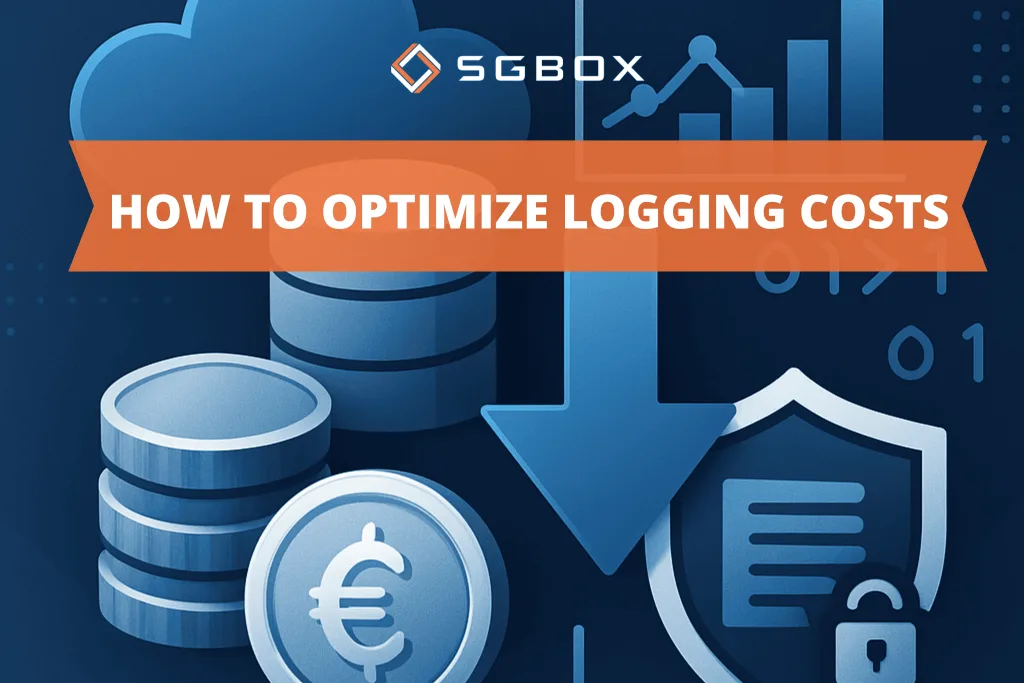11 ways to optimize logging costs

How can you optimize log-related costs?
In an increasingly data-driven world marked by constantly evolving threats, efficiently managing logs becomes a key strategic lever: it’s not just about controlling costs, but about ensuring operational visibility, security, and compliance without unnecessary expenses.
Adopting a Log Management platform allows you to achieve the right balance between visibility into security data across IT (Information Technology) and OT (Operational Technology) environments, while reducing overall costs.
Here’s how, together with SGBox, you can turn log management into an efficient process that creates a competitive advantage in terms of security and compliance.
1 – Define log retention policies
Keeping every generated event may seem like a cautious choice, but it often results in unnecessary expenses. Logs must be segmented by importance (critical / operational / less relevant) and assigned appropriate retention periods.
SGBox helps companies map log flows, define retention policies aligned with regulatory requirements (e.g., GDPR, NIS2), and automate archiving or deletion at the end of the useful lifecycle.
2 – Filter based on log level
Not all logs have the same value, meaning some are redundant and unnecessary for initiating security activities. Irrelevant, low-value logs should be reduced, as they can negatively impact SOC team operations.
SGBox supports the configuration and monitoring of log levels in complex environments, helping filter out priority alerts that are truly useful for security operations and audits.
3 – Use log compression
The volume of collected logs can grow quickly and disproportionately. Applying compression techniques reduces storage space and transfer costs without compromising accessibility.
SGBox offers integrated solutions for log compression and archiving, ensuring that data remains available for analysis while occupying fewer resources.
4 – Centralize Log Management
When logs originate from multiple applications, microservices, and regions, spreading them out makes analysis, correlation, and cost-control significantly harder. A centralized platform provides visibility, aggregation, and control.
SGBox delivers an advanced Log Management and SIEM platform that centralizes logs and security events, streamlines analysis procedures, and optimizes storage and access, reducing duplication and inefficiencies.
5 – Monitor and control log ingestion
Controlling which logs are ingested avoids allocating financial and technological resources to store unnecessary data. It’s important to set thresholds, control metrics, and anomaly alerts for log ingestion.
With SGBox, you can define automatic rules and alerts for log ingestion, exclude irrelevant traffic, and act quickly in the event of unexpected variations or spikes.
6 – Analyze data before archiving
Not all data deserves long-term storage. Enrichment and normalization at the point of entry allow filtering, aggregation, and transforming logs into more useful and compact formats, reducing costs and improving analysis quality.
SGBox supports data-enrichment pipelines, log transformation, and intelligent filtering so that only data truly needed for security, auditing, and actionable SIEM inputs is retained, optimizing threat detection performance.
7 – Use Tiered storage
Not all logs require the same level of accessibility: recent logs are consulted frequently, while historical logs are typically used only for audits or compliance. Using lower-cost storage tiers (cold, deep-archive) leads to significant savings.
With SGBox, you can define automatic policies that move logs across tiers (hot → warm → cold) based on usage, ensuring fast access where needed and more economical storage elsewhere.
8 – Automate Data Lifecycle Management
Manual interventions and sporadic actions lead to errors, hidden costs, or unnecessary data retained for too long. Automating the entire lifecycle, from collection, to tier transitions, to deletion, is essential.
SGBox integrates automation features for lifecycle management: automatic log transitions, scheduled expiration and deletion, all in line with internal policies and applicable regulations.
9 – Optimize indexing strategies
In log search engines indexing determines both cost and performance. Poor choices inflate costs.
SGBox supports companies in designing efficient log-search architectures: optimized mappings, shard/replica management, index rollover policies, and snapshot & archiving strategies that reduce costs and improve response times.
10 – Use cost governance tools
Understanding where money is spent, forecasting increases, and setting budget thresholds help maintain control over logging-related expenses. Dashboards, reports, and alerts are essential.
SGBox offers economic visibility across the entire log stack: dedicated reporting, cost driver analysis, alerts, and support for defining operational budgets, avoiding unexpected billing surprises.
11 – Apply log sampling
In high-volume environments (IoT, microservices, heavy traffic), recording every event can become prohibitive. Sampling consists of storing only a selected percentage of less-critical events while maintaining visibility into errors and anomalies.
SGBox helps define structured sampling policies: clear criteria (errors, security events, user behavior), dedicated flows for critical and non-critical events, and continuous monitoring of sampling effectiveness.
Discover SGBox Log Management >>

